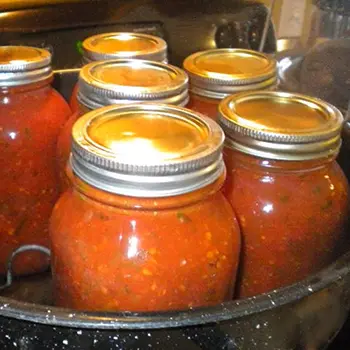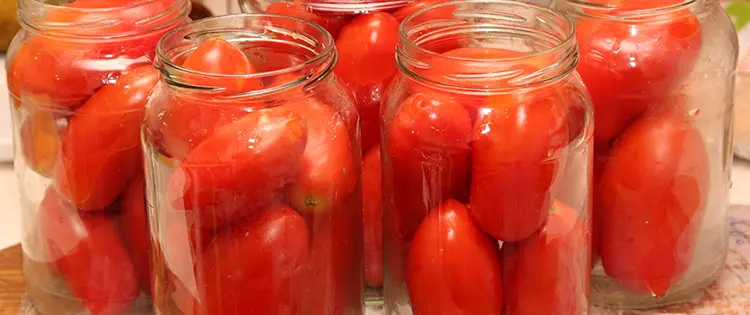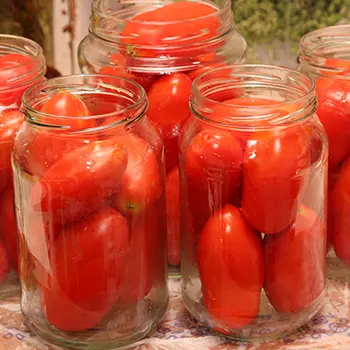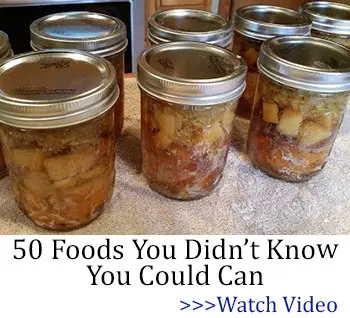When we start to talk about preserving, we usually end up with a canner on our counter. That will be the case for this article, but I must note that you can certainly preserve tomatoes in other ways. You can dry them in a dehydrator or freeze finely chopped bits of them for use as toppings in any number of dishes throughout the rest of the year.
Tomatoes are extremely versatile, but let’s be honest: When we think of tomatoes, we think of them in a can in the middle of the grocery store. Or we think of them fresh off the vine, but that season is quickly disappearing on us as of this writing. What will we do without our delicious friends? And what are we going to do to keep them around during the off-season, until we have them back again at the end of next summer, ripe and ready for more delicious meals?
Related: Tomato
It’s time to start preserving tomatoes and, perhaps, even a little past. Some areas are likely getting their last few tomatoes off the vine while those of us in the later zones are still seeing profuse fruits even now. I know mine are still popping, especially my later-season plantings, and I have so many tomatoes that I don’t know what to do with them all.
Or do I?
Let’s jump right in and discover a few quick and easy recipes for your bountiful, late tomatoes. Please note, that if my directions differ from what your canner states, please listen to your canner. In most cases, I don’t give canner directions at all; you should use your guidebook because it will be correct for your particular machine. As always, I want my readers to remain as safe as they can. Canning is a serious process and should be undertaken by adults who know the risks and how to avoid them. Do not underestimate your canner and do not operate one unless you know what you’re doing or you’re willing to take the time to read the manual before you start and learn how to do so.
Basic Spaghetti Sauce
Cut your tomatoes in half and gently peel them. Slice them into several small pieces and add them to a large, deep pan (or pot) with a little oil in the bottom. Cook these down until you have a warm mash, gently pressing on the backs of the tomatoes to pulverize them as they cook. You may also do this in an oven, but a pot/pan is faster.
Remove the tomatoes and run them through a sieve or a cheesecloth if you desire your sauce to lack seeds. If you don’t mind seeds, skip this step.
Put your tomato mush into a food processor and puree. Please note that any leftover skin will get caught in your blades and make an absolute mess. Please make certain that you don’t have anything left. If your puree is too thick to cut down, feel free to add a little warm water. You’ll be adding more soon, most likely, anyway. If it is extremely liquid, don’t worry about it. You can always cook your sauce down to remove extra water along the way, too.
Related: Pioneer Recipes Every Homesteader Should Learn
To the original pot, add fresh oregano, fresh basil, minced onions, and salt and pepper to taste. If adding garlic, I recommend garlic powder instead of whole cloves. Allow this to cook in the oil and tomato juices until fragrant. Add the tomato back to the pot and allow the onions to cook down until they are fully softened. If very thick, add water to the half cup until the desired consistency is achieved.
Please use your canner instructions on how to can your new spaghetti sauce. I recommend using glass if at all possible simply because this makes it easier to see if you have a great deal of oil separation; which can be easily fixed by shaking the jar gently before opening.
Whole Tomato Preservation
This is less tricky than spaghetti sauce. Wash and peel your tomatoes, then submerge them in a pot and boil them until easily pierced by a butter knife. While we recognize that this is a strange concept, you want the ability to watch one slide down the knife as one may consider trying to kebab a tomato.
Once they make it to this point, drain them into a colander and allow them to fully cool before you place them in your jars. I do recommend only 2-3 large tomatoes (beefsteak) or 10-15 cherry tomatoes in a 1-quart jar to allow them enough room to move around in the fluid that you use to preserve them. Still looking for one? Vinegar and sugar make incredibly good sweet pickled tomatoes, but plain old salty water works just as well.
When canning whole tomatoes, please remember that if the tomato is not fully cooked you will have a sour, acidic taste throughout the entire can.
Again, I recommend using your canner’s directions but I prefer to add five pounds to the requirements of your canner just to get a very, very heavy seal. The slightest seepage with this particular method will end in disaster.
Adding Tomatoes To Other Projects
Perhaps you love okra and tomato stew or you’re a big fan of fresh goulash. You can absolutely preserve these recipes with simple canning instructions, but I personally recommend freezing them instead. Cook up a huge batch and use 1-gallon freezer bags to store and freeze these recipes for up to a year in a deep freezer.
Just make sure that the soup or stew is completely cooled before you start preserving it in the bags since freezer bags are likely to melt through if not.
Final Thoughts
How do you prefer to preserve your tomatoes? Is there a favorite recipe that you expected to see on here, something impressive that I missed? Let us know in the comments down below and join us again soon for more exciting harvest preservation tips!
You may also like:
The Ultimate Survival Food You Can Only Harvest This Fall (Video)
5 Amish Gardening Techniques You Should Know











